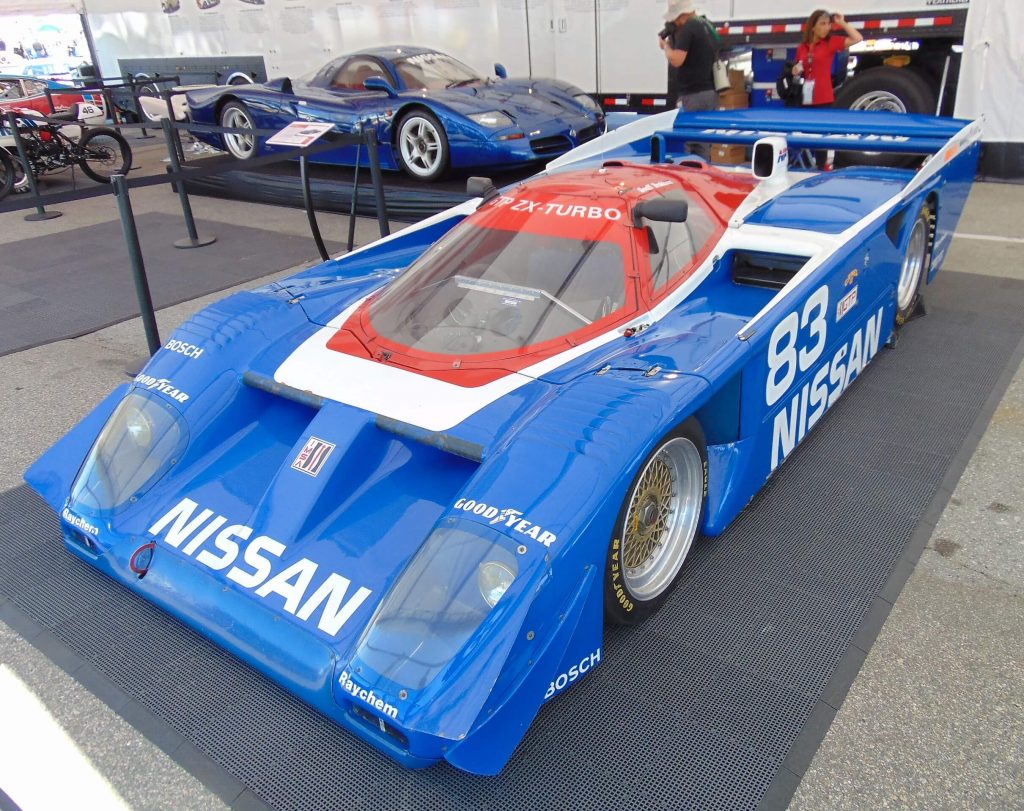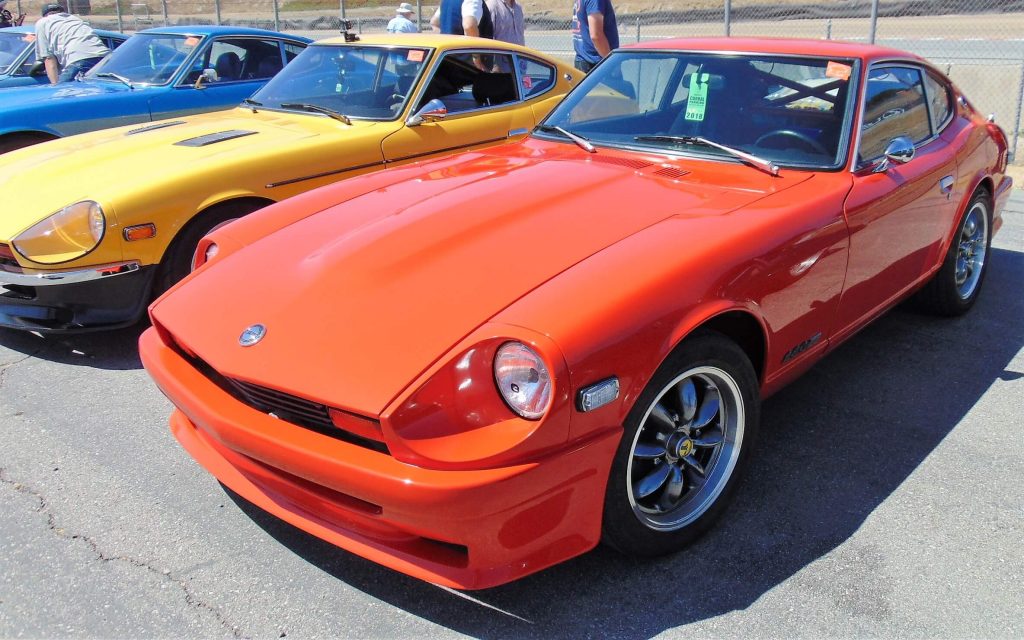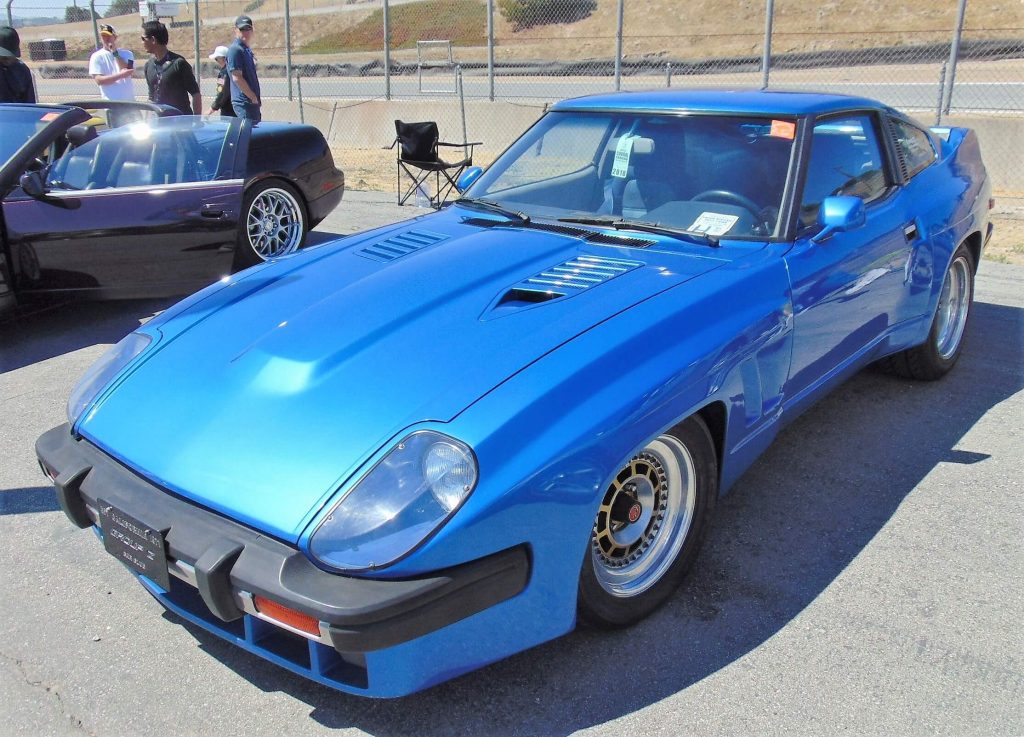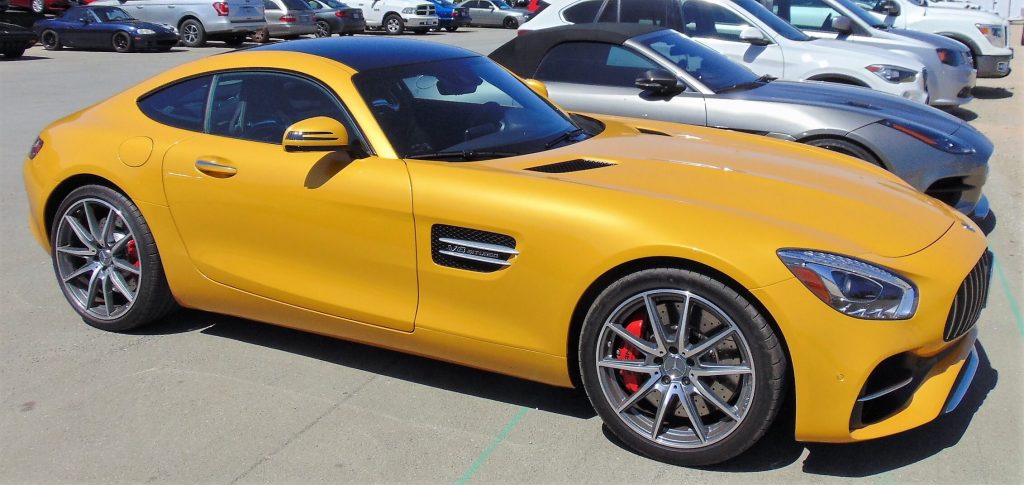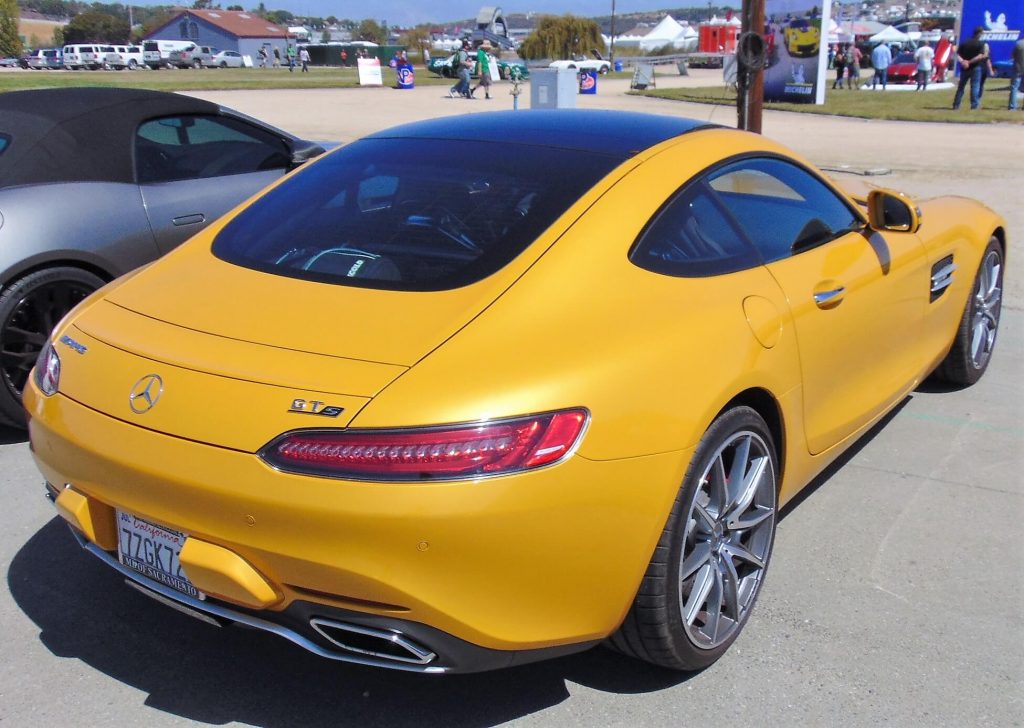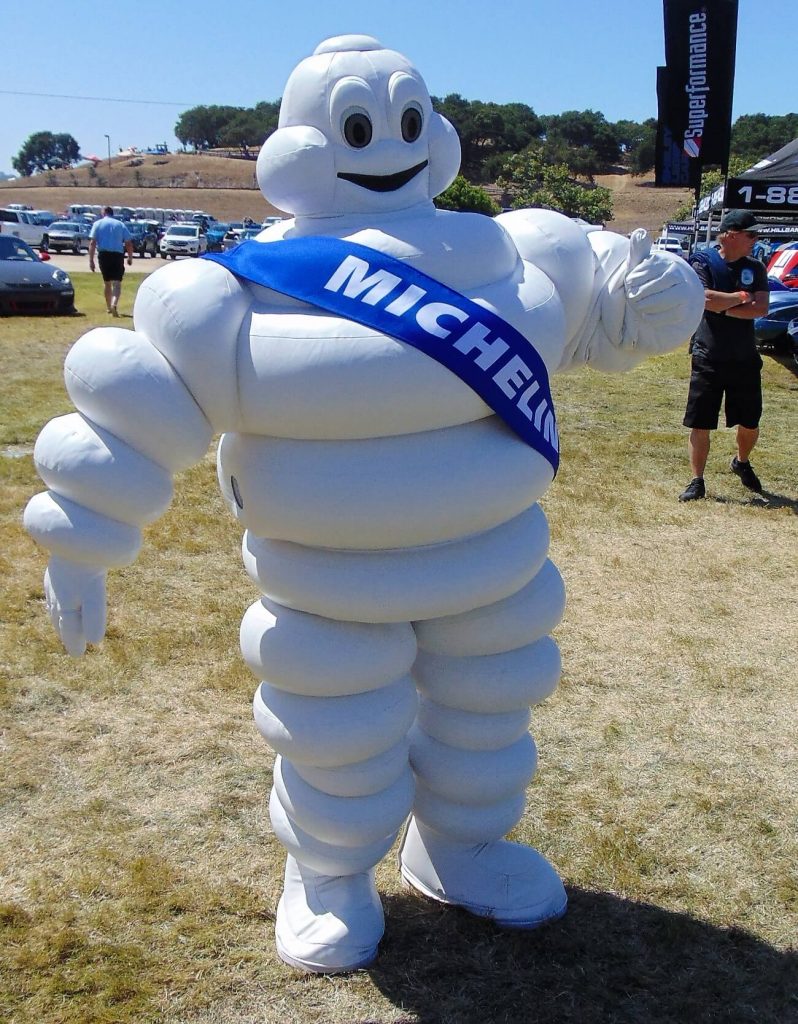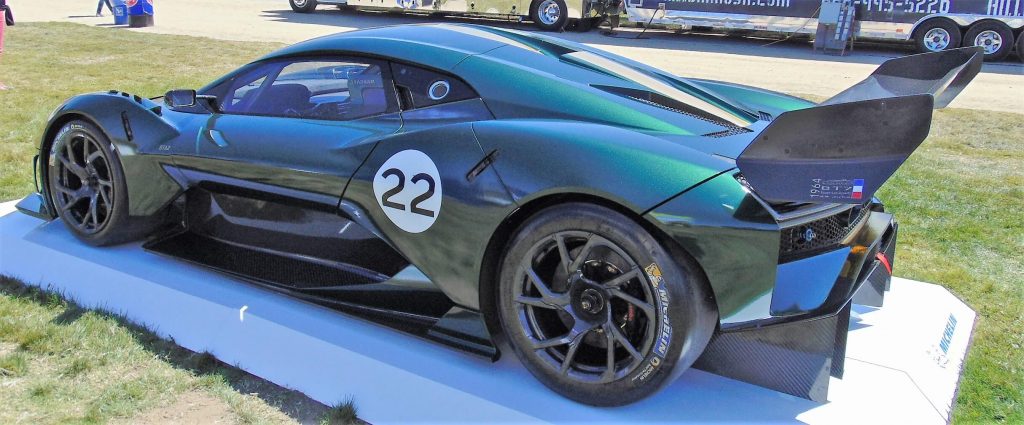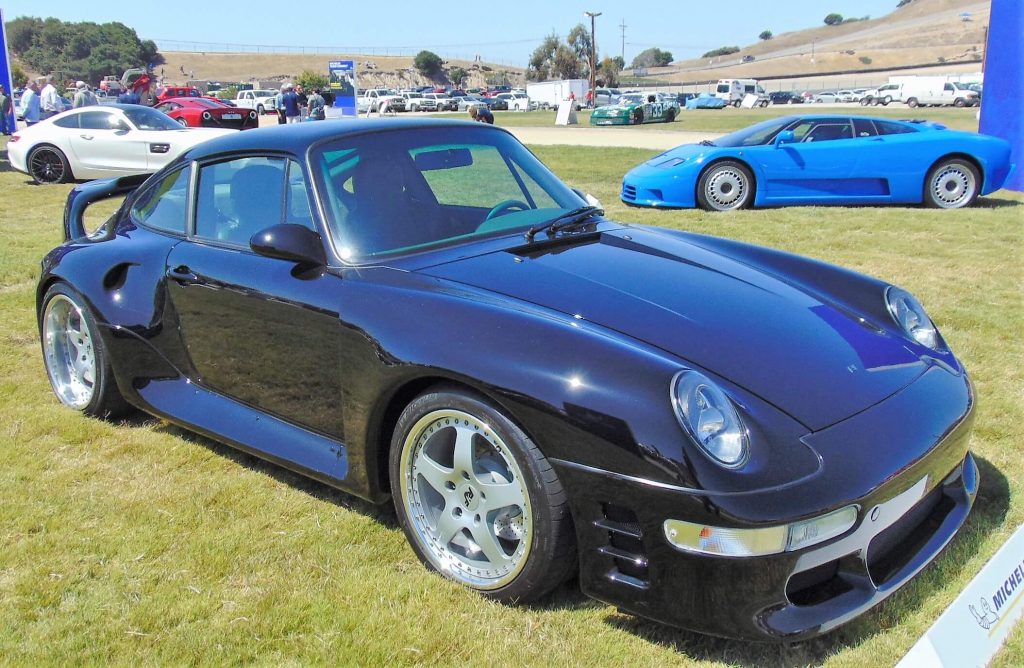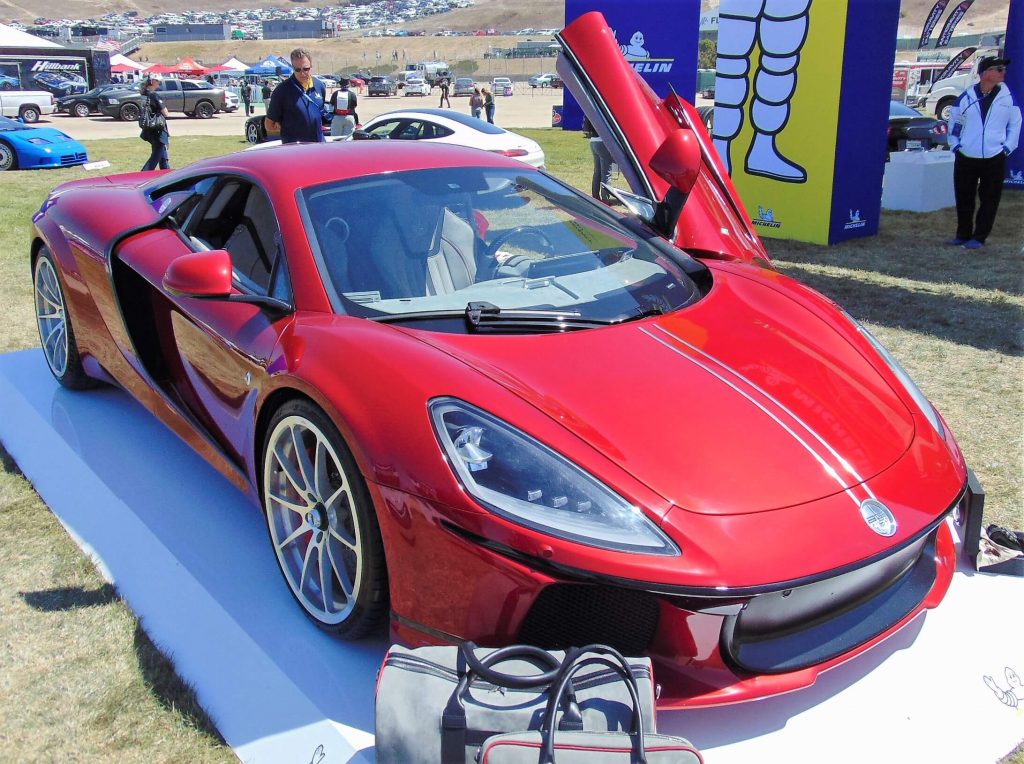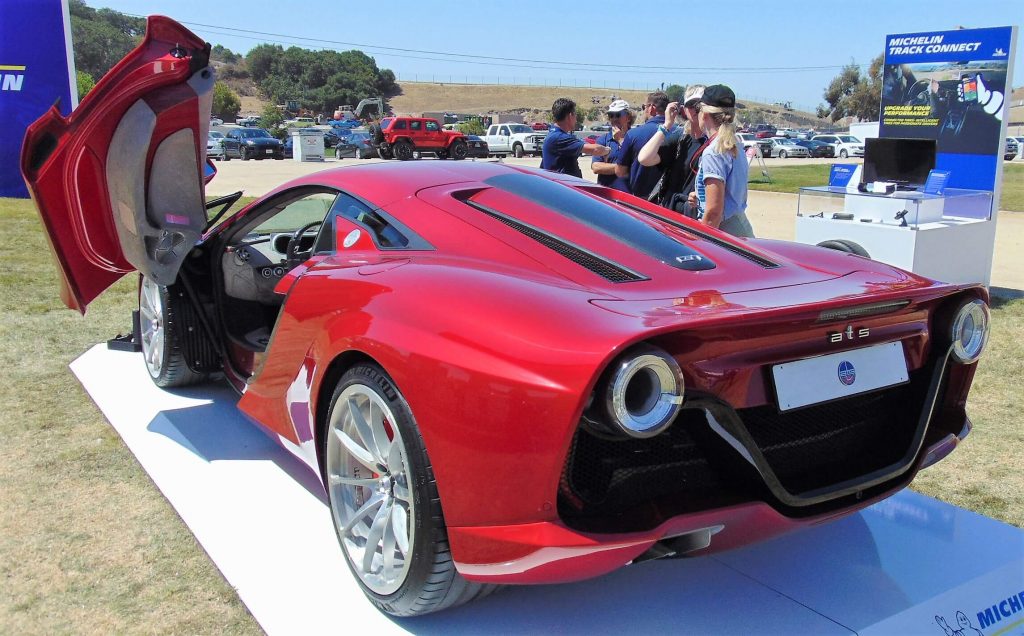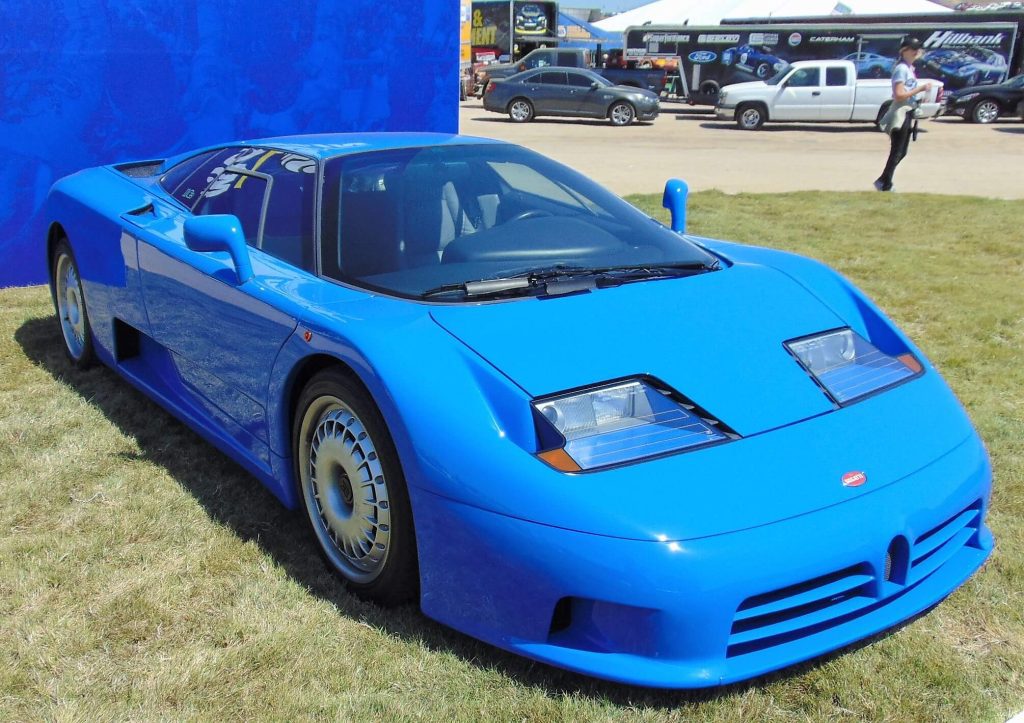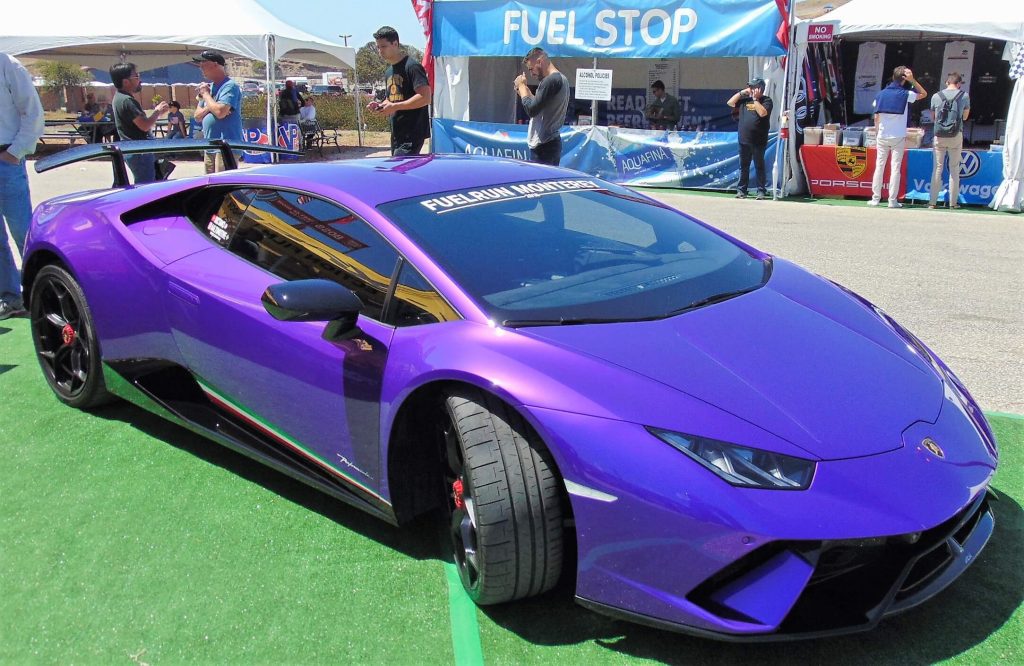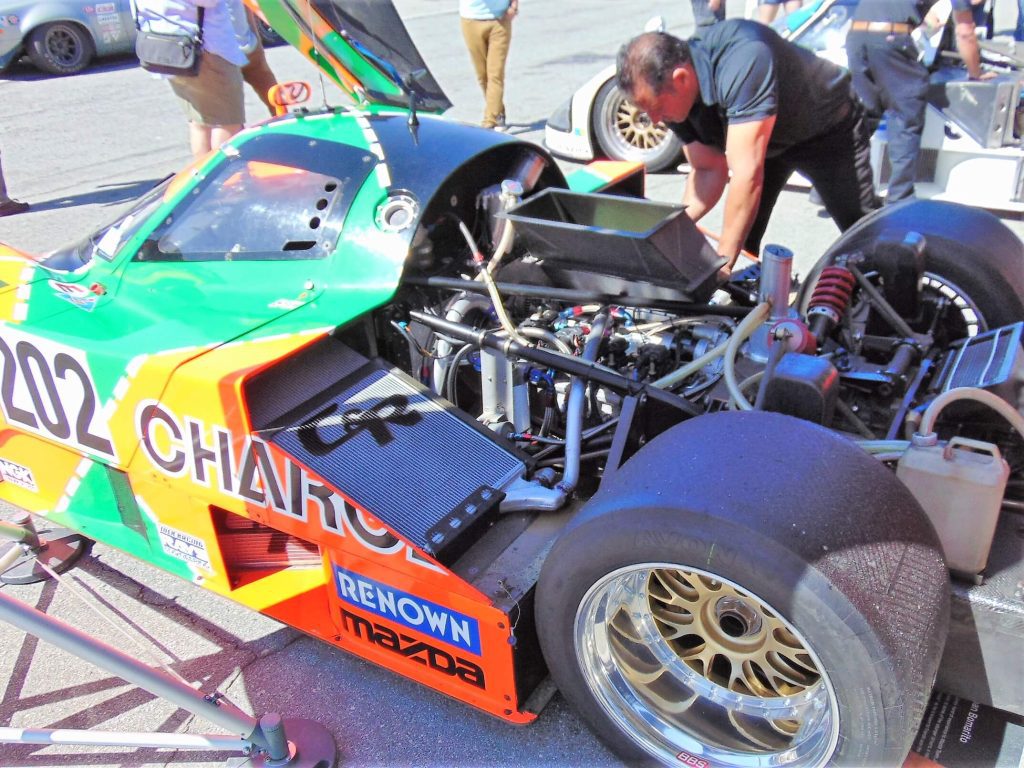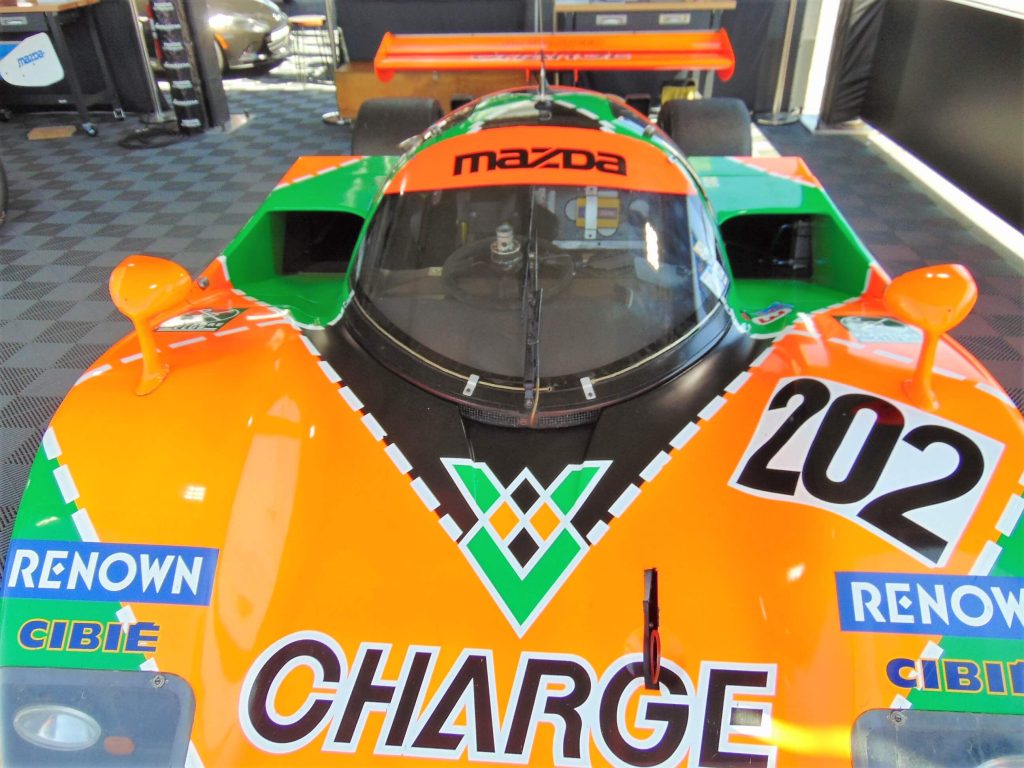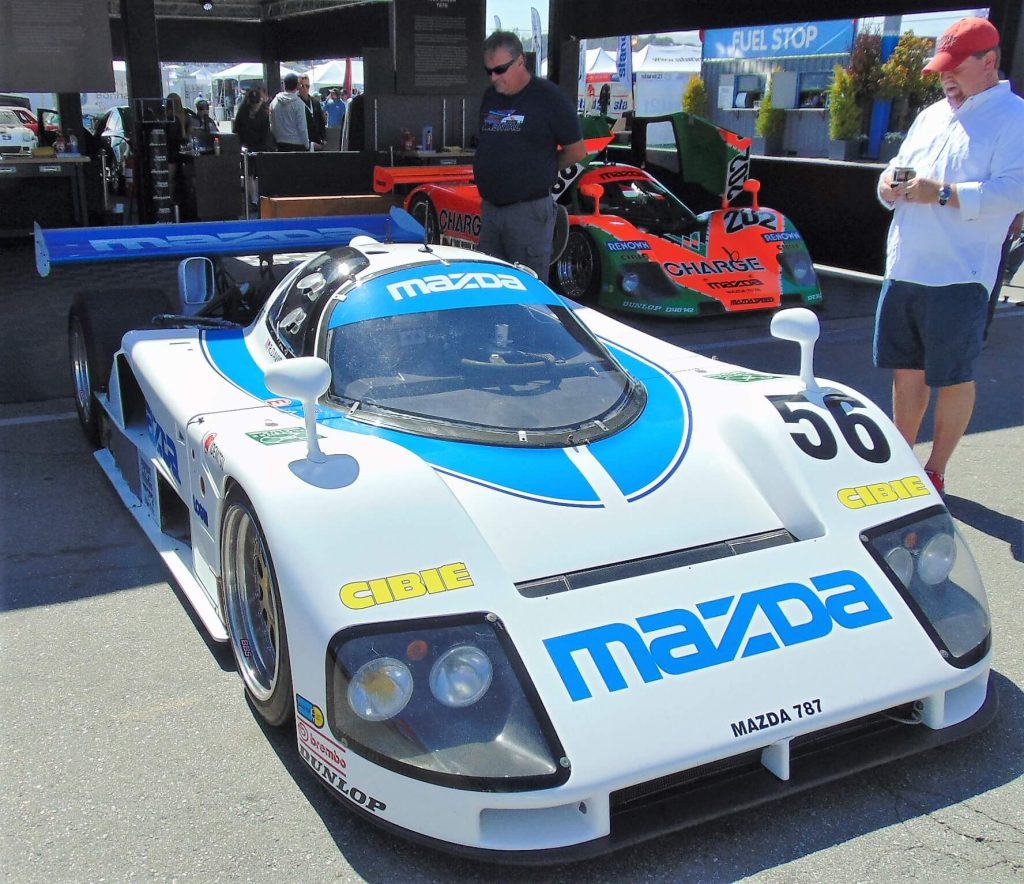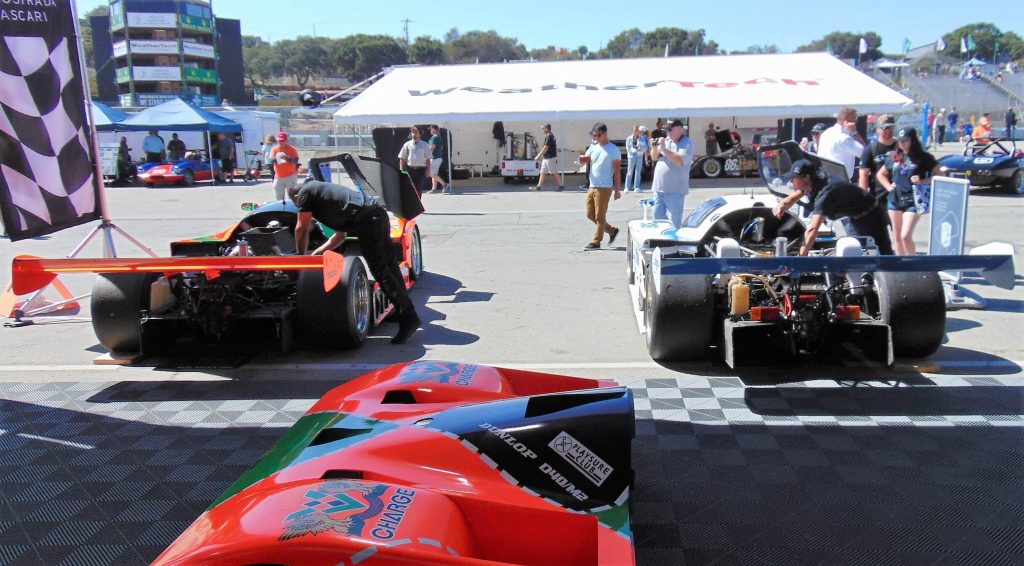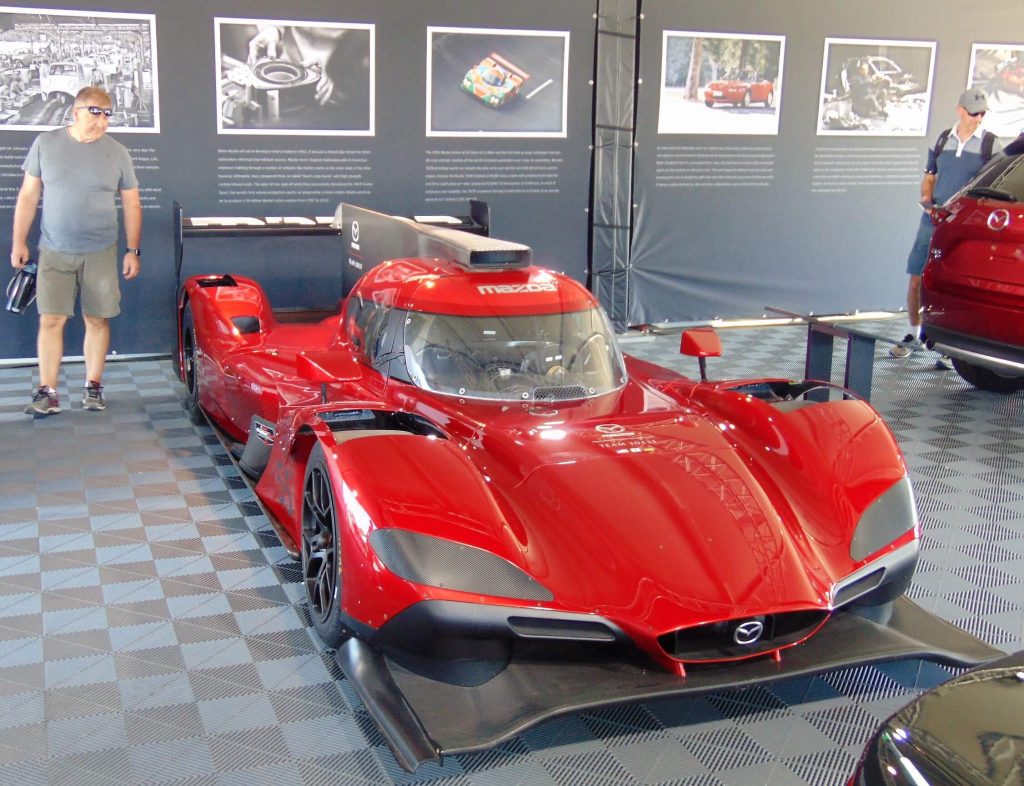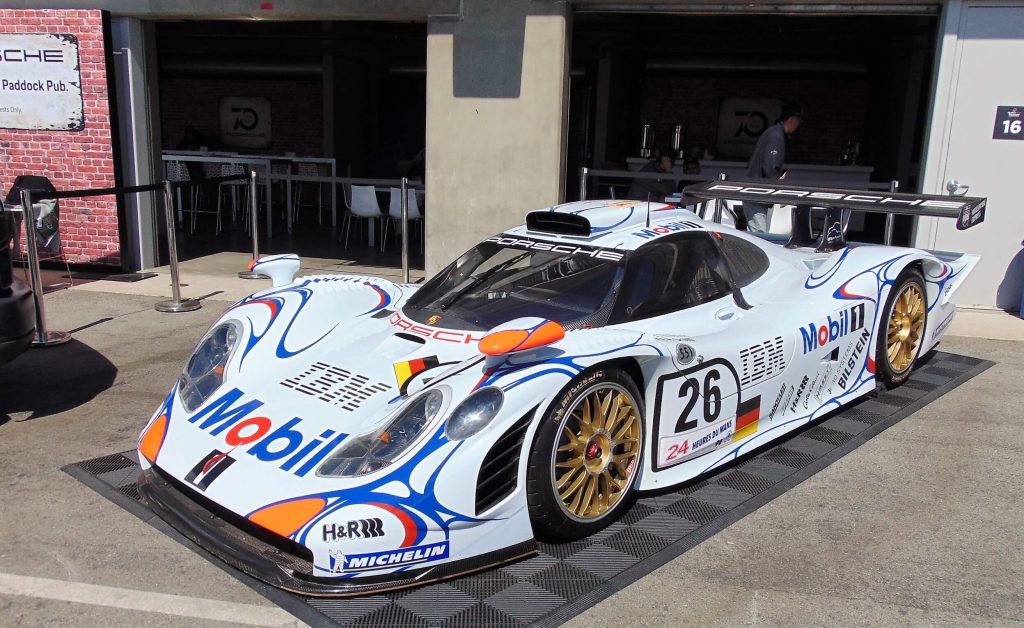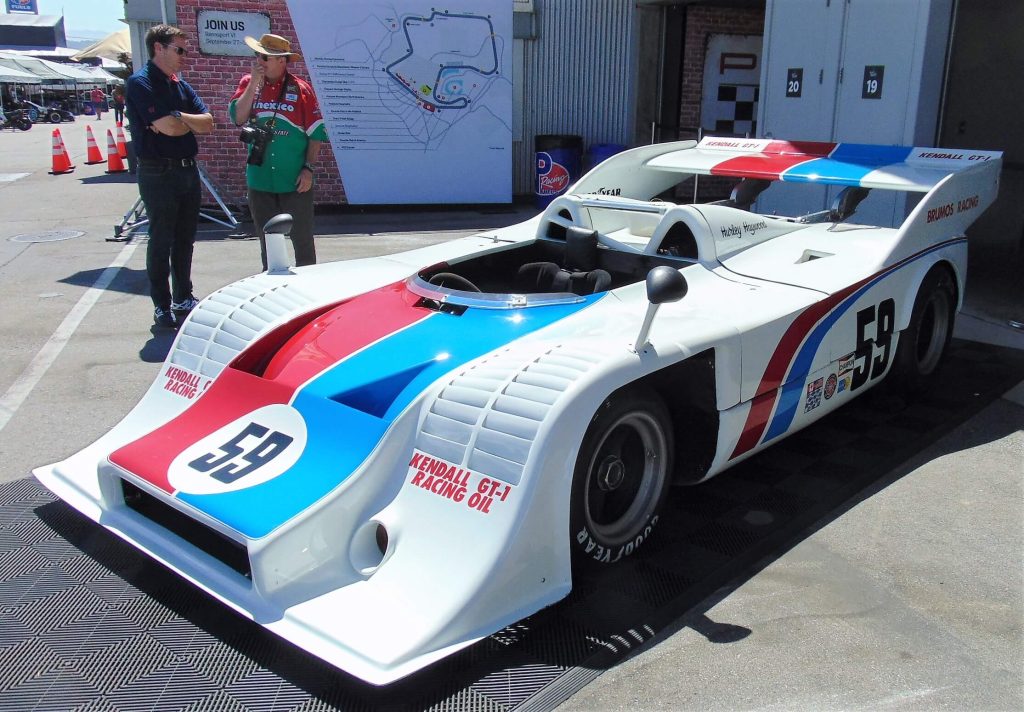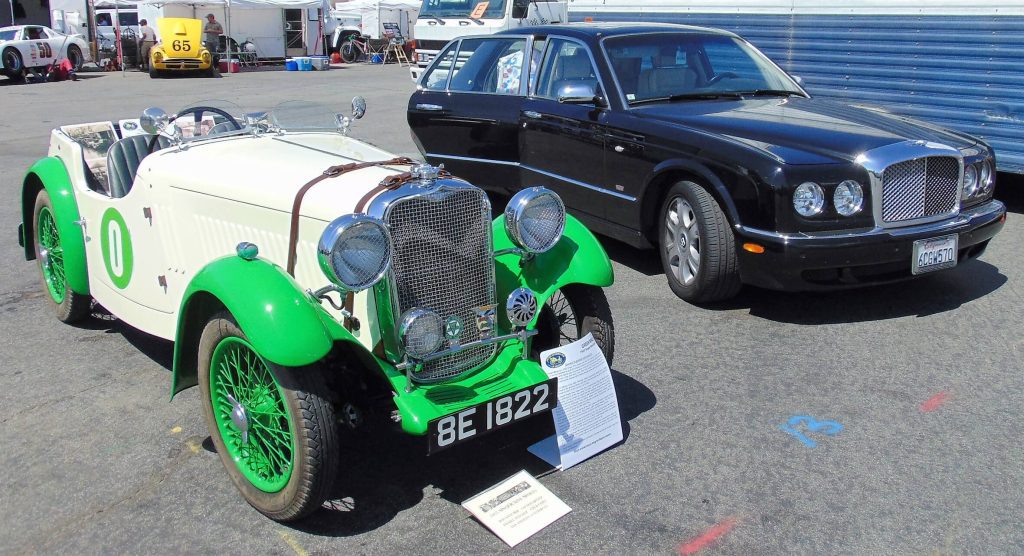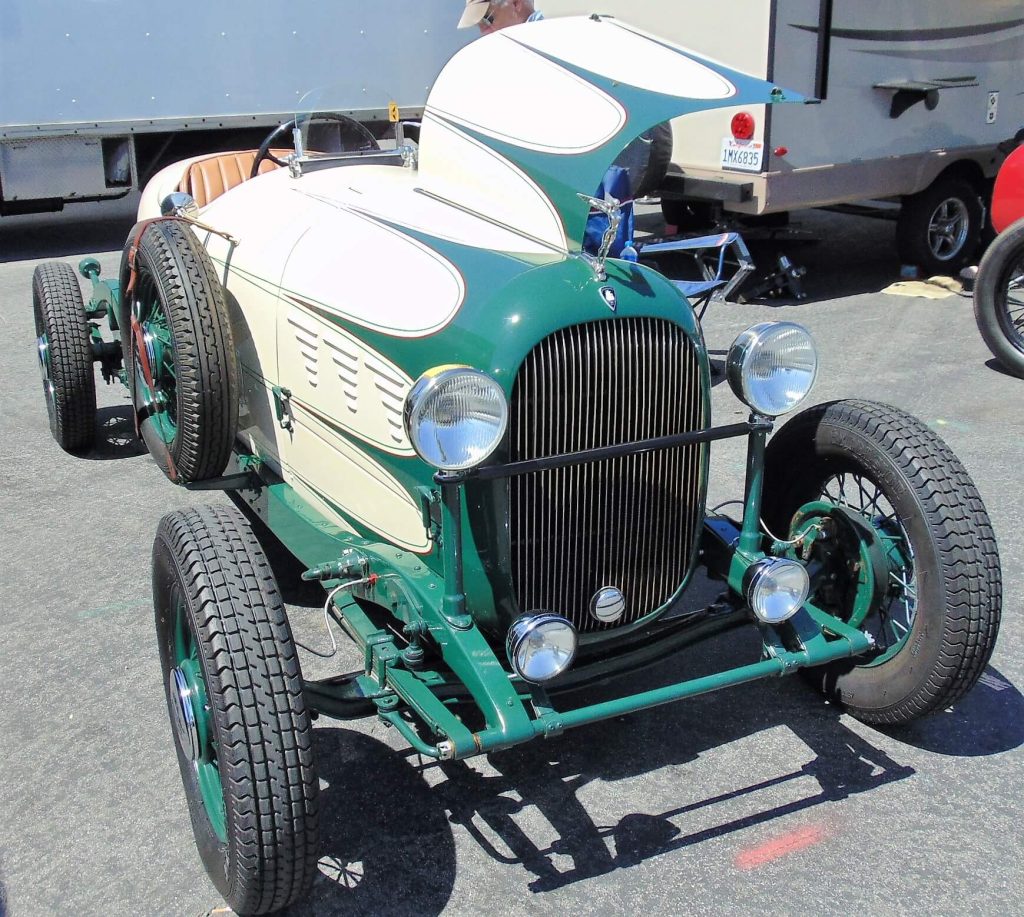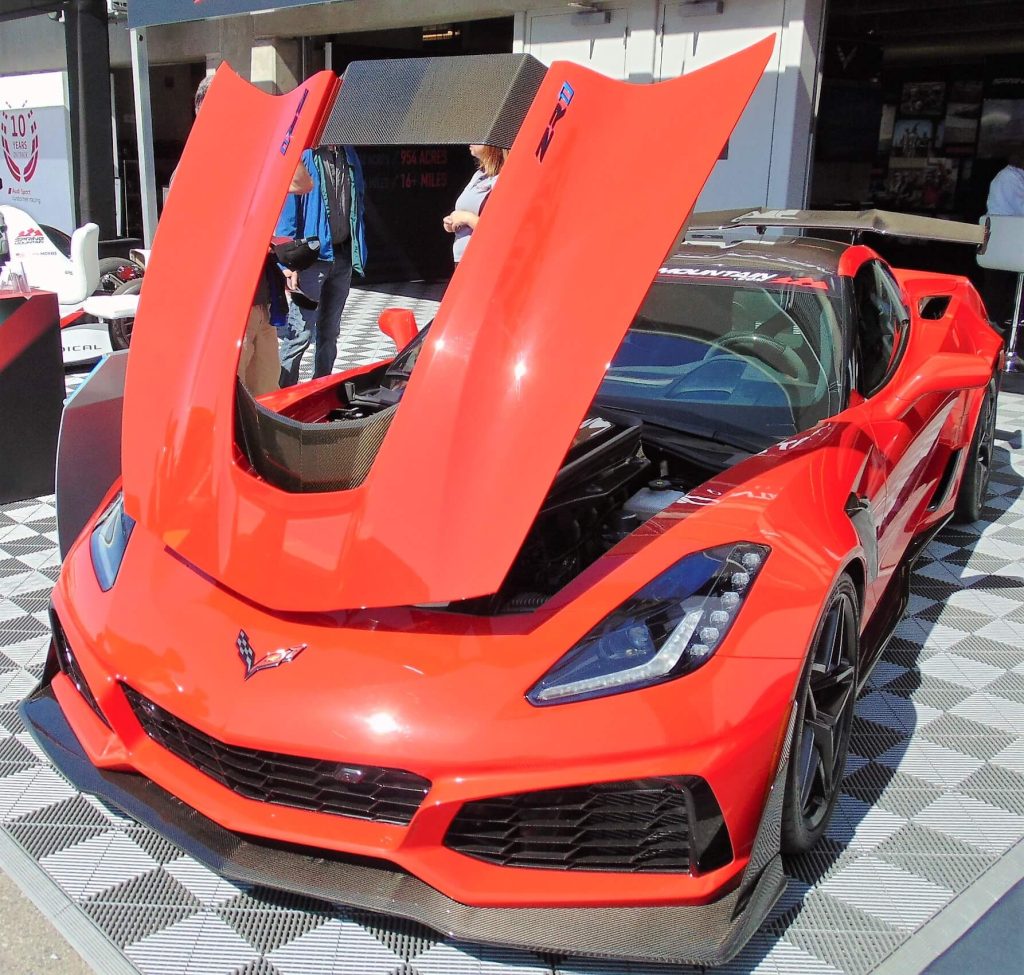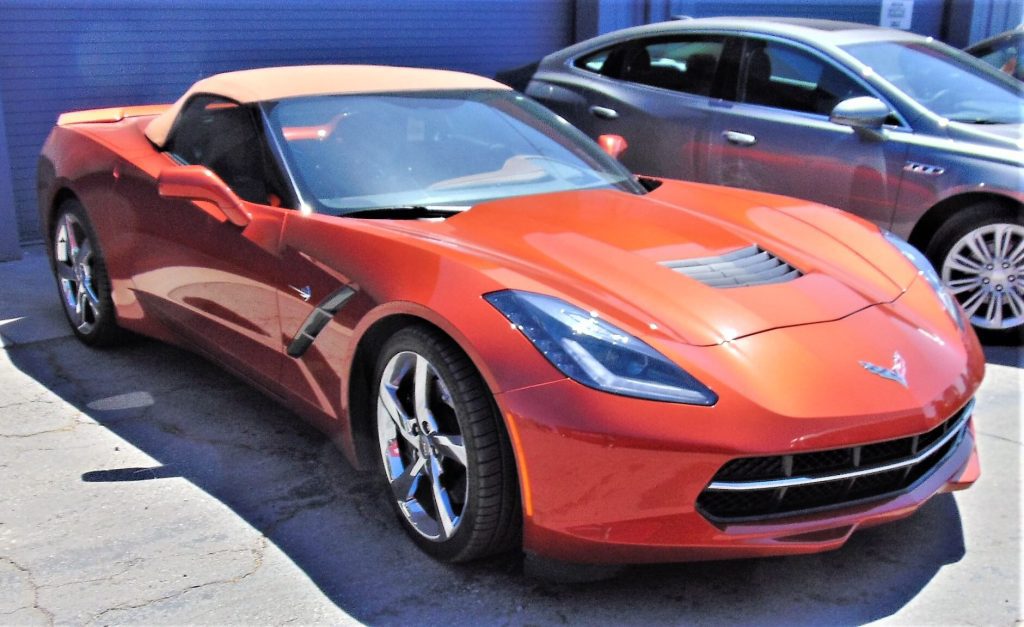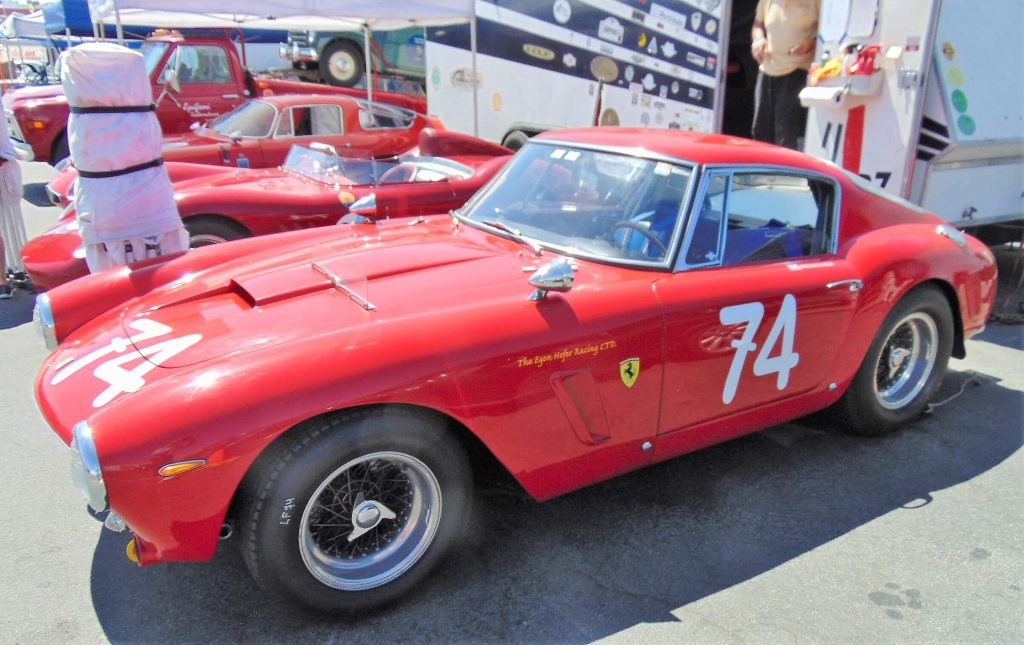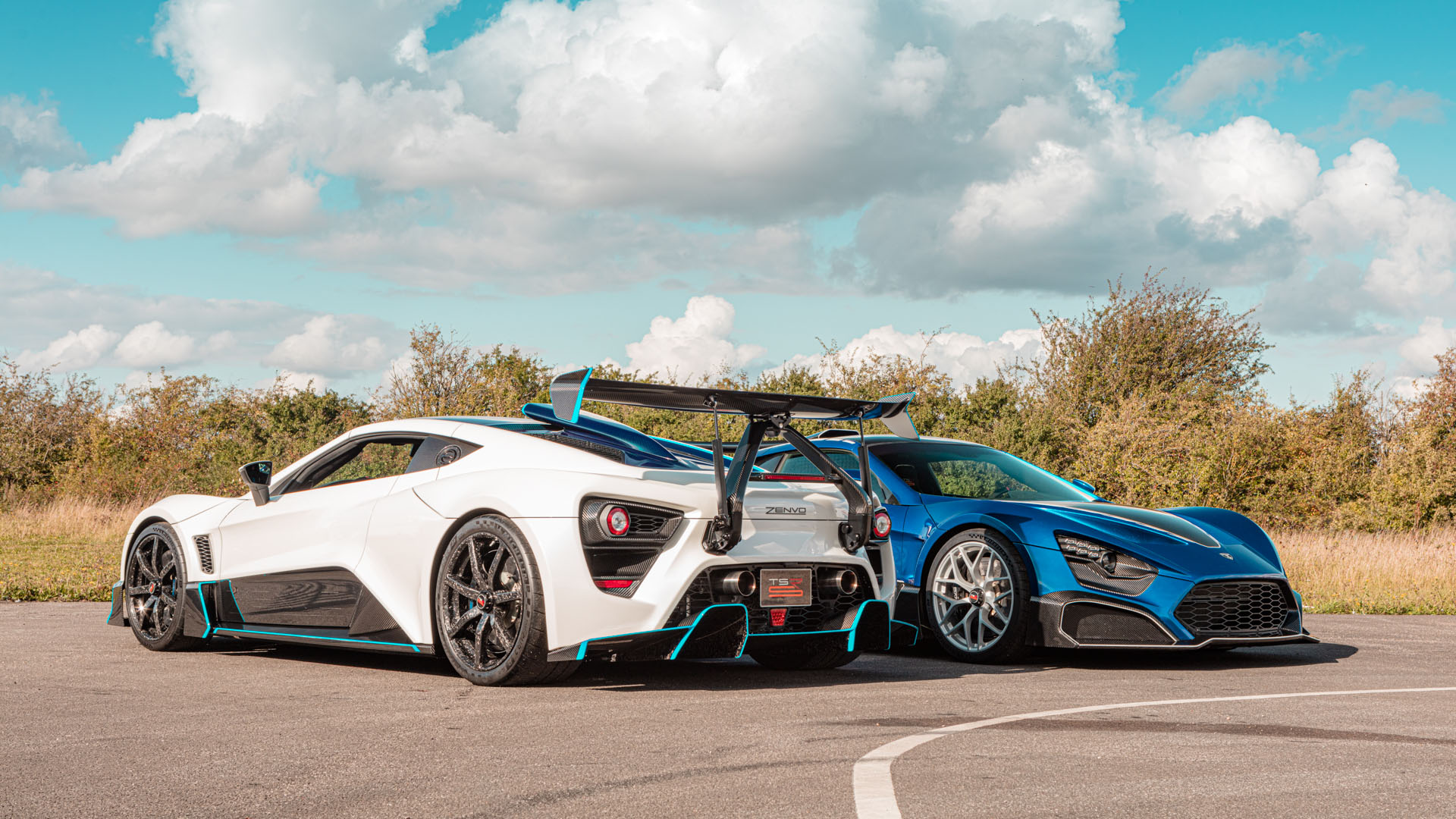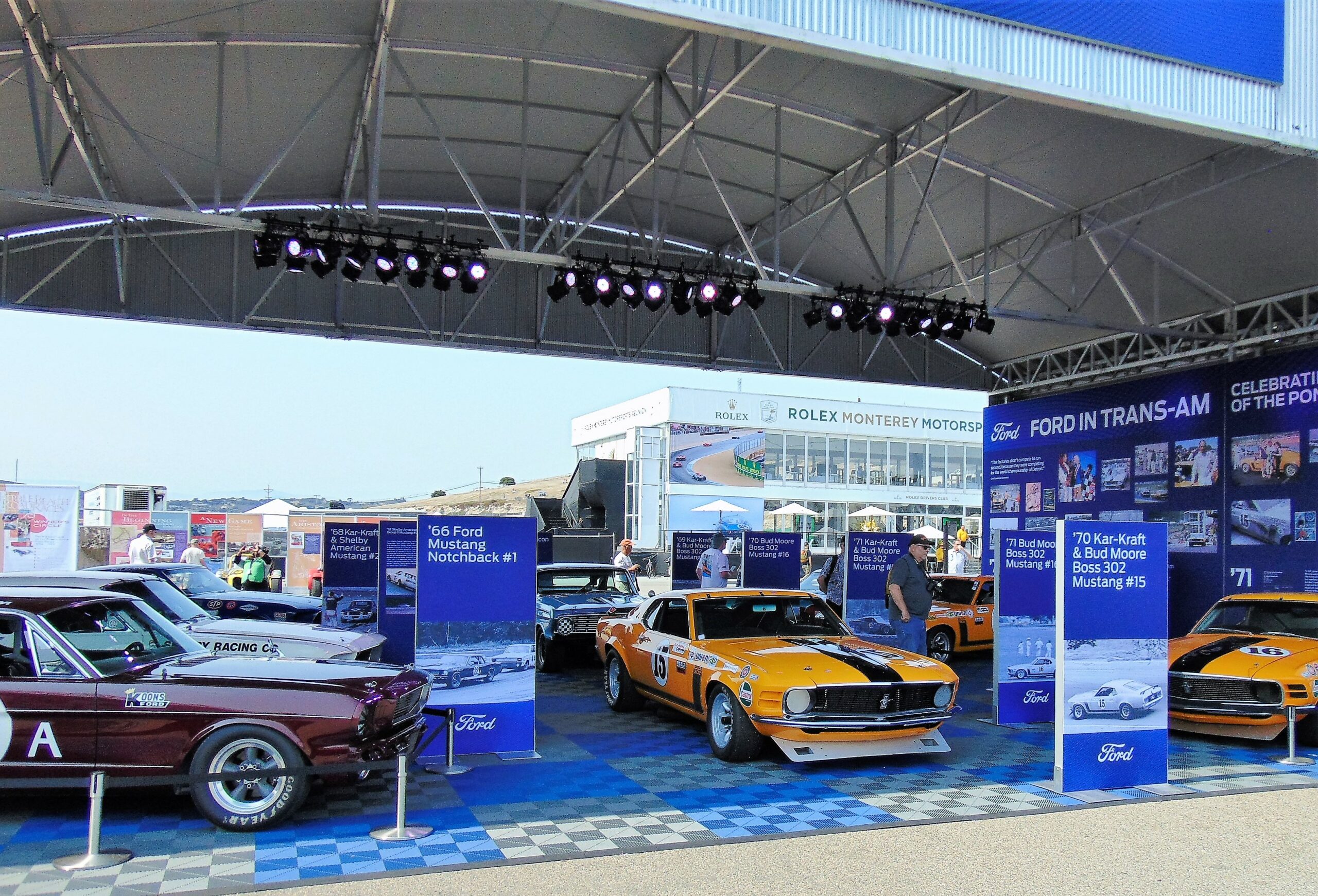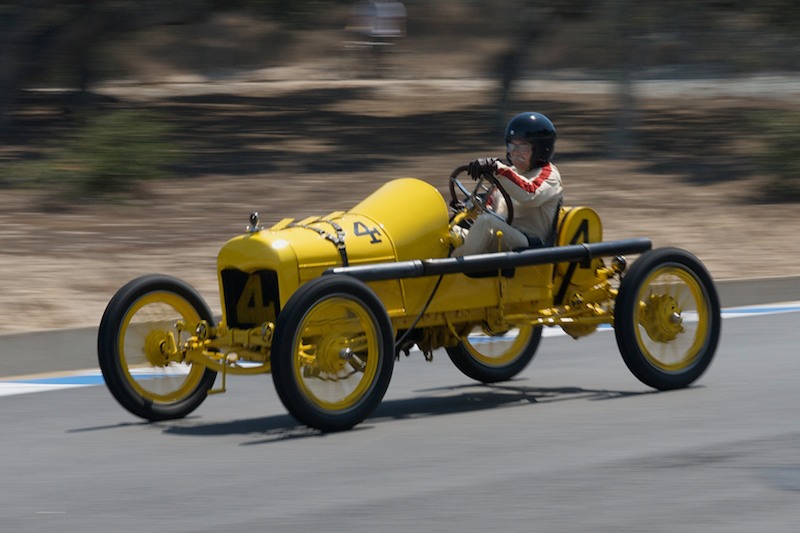Someone once said, “Good race car drivers never lose, they just run out of time.” It’s true. When that checkered flag falls it’s over! But at the Rolex Monterey Motorsports Reunion the race cars return over the ensuing decades, time after time, seeking and sometimes obtaining the checkers for first place.
A First Look at Nissan
Nissan was the first ever Japanese auto manufacturer to be recognized as the featured marque at the Rolex Monterey Motorsports Reunion, August 23-26, 2018 at WeatherTech Raceway, Laguna Seca. Nissan’s large display was located on the main artery through the paddocks lying perpendicular to the other main artery leading to Automotive Alley.
Nissan GT-R50 Slate

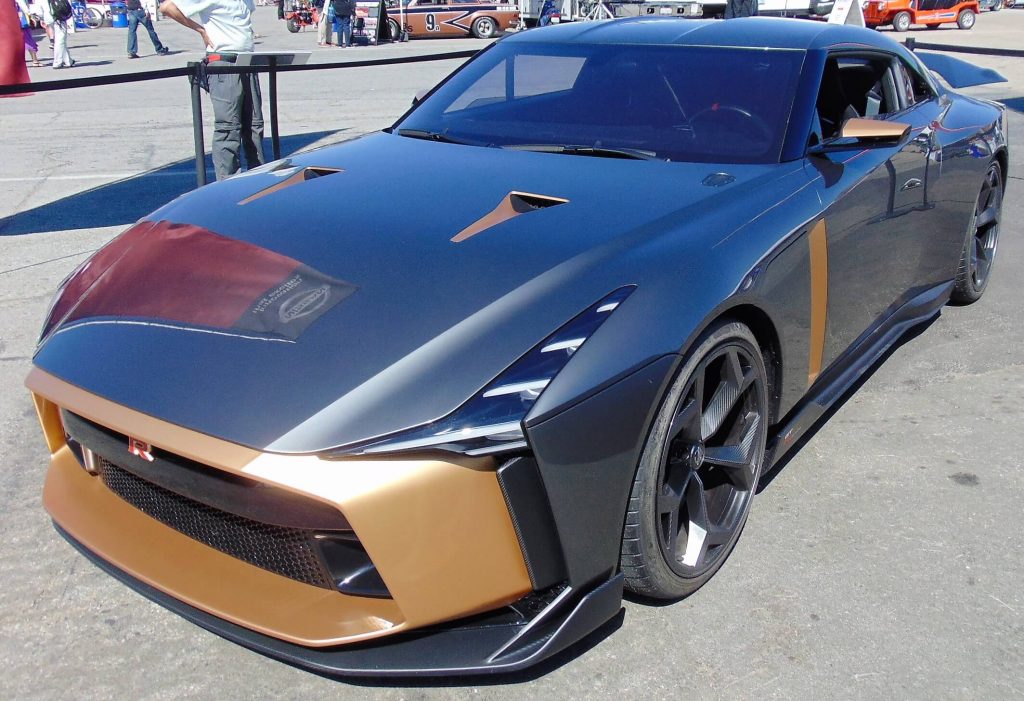
One of Nissan’s most impressive pieces was their new GT-R50, an evolution of the GT-R initially produced in 2007. Alfonso Albaisa, Nissan’s senior vice president for global design called this a rare window in time that the opportunity is open to creating a car without limits, and additionally get to build it, as is the case for the GT-R50 when Nissan and Italdesign created the car.

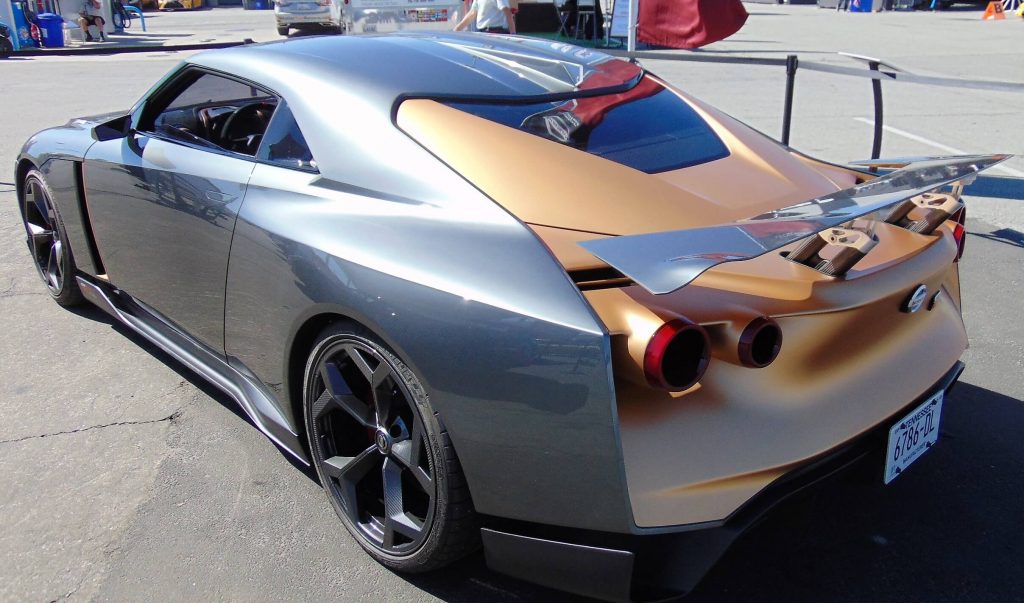
This is a bold style, which I liken to a “brute”, after the architectural style which I admire of the same name. The bold planar panels appeared in fitting colors for my taste, graphite with copper-gold trim.
The powerplant is a twin-turbo 3.8-liter V6 boasting 710 hp and 585 ft-lb of torque administered through a six-speed dual-clutch transmission. The car rides on 21-inch wheels with a rear wing providing down-force.
Nissan R390 GT1 Blue

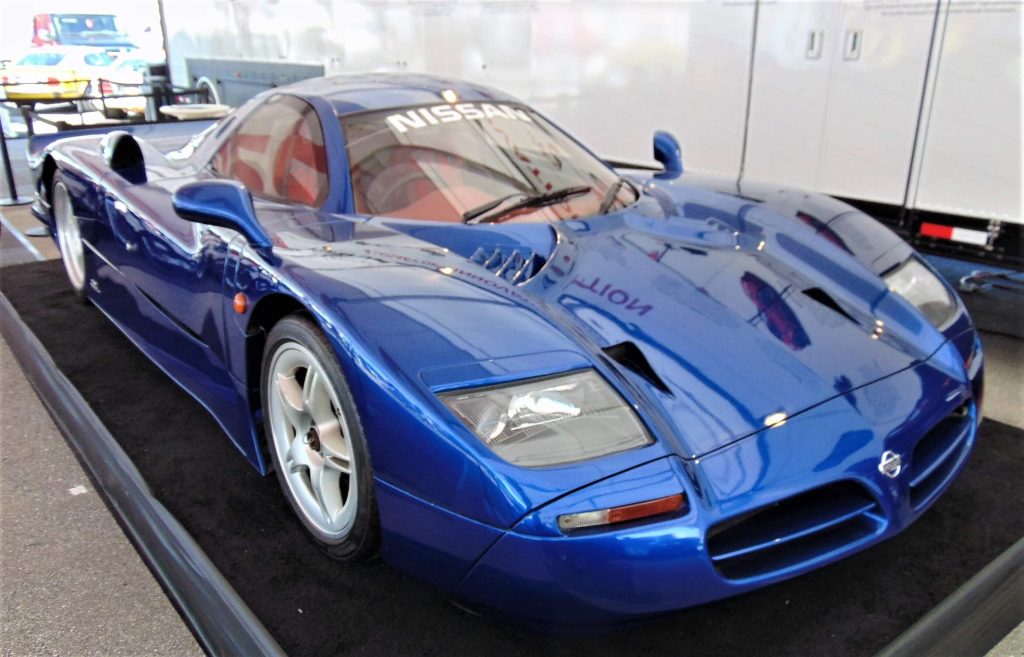
Among Nissan’s race cars on display, was a dark-blue R390 GT1 designed for the 24 Hours of Le Mans in 1997-98, employing a 3.5 liter, longitudinally-mounted rear-mid-engine with twin-turbochargers. Also on display was a 1988 blue and red Nissan GTP-ZX powered by a turbocharged V6 turning 8,000 RPM, generating 850-900 hp, and scaling in at 2,095 lbs.
Nissan GTP-ZX Blue
As I have said before, walks around the entirety of the area enclosed by the WeatherTech Raceway Laguna Seca during the Rolex Monterey Motorsports Reunion are always fruitful. This year was no exception.
I headed for the Park by way of the bridge leading to the Marketplace. After the bridge, there is a choice of left to the Marketplace, or right to one of two owner’s car corrals, the one strung out along the race track. I selected right because that way I could inspect the owner’s Nissan Z-cars cars before arriving at the Park.
Datsun’s Shine
There were plenty of Datsun Z sports cars presented in a myriad of attractive paint styles along my walk to the Park of the 240, 260, 280, and 300 varieties. The cars really need to be seen to appreciate them and their colorful paint, but just a few of the coats of well-polished paint that especially caught my attention were orange, black, white, graphite, yellow, and blue.
The Z-series was produced over 1969–1978. The reason? To compete in an economical format with recognized European sports cars. People around then, especially in California, could not miss them on the roads during that period. The styling, good engineering, reasonable price, and responsive performance was a hit. Waiting lists at dealers ensued.
Datsun 240Z Orange
The 240Z offered a 2.4 liter inline-6-cylinder engine yielded 151 bhp and maxed at 7,000 RPM. Soon came the 260Z equipped with a 2.6-liter engine generating 162 bhp.
Datsun 260Z Blue
The 280Z, an evolution, increased engine size to 2.8 liters giving 170 bhp and offered a four-speed or five-speed manual transmission, or automatic.
Quite a successful reign. Eventually, the Datsun Z was succeeded by the Nissan 300ZX (Z31, 1983–1989, Z32, 1989–2000).
Mercedes Benz AMG GTS
The area I was in exits into a much larger parking area that also houses more owner’s car corrals when needed. Here, I soon came across a 2018 Mercedes Benz AMG GTS (2014-present) in yellow paint. I like yellow on some makes, but less so on others. This GTS was stunning in yellow! The color just seems to fit.
The GTS is powered by a 4.0-liter twin-turbo V8 producing 515 hp and 495 ft-lb of torque applied through a 7-speed dual-clutch transmission. An electronically controlled limited-slip differential, several race mode settings, and an adaptive drivetrain including suspension controls enhance performance and drivability. The long, sleek automobile weighs in at about 3,600 lbs.
The Michelin Display at BBQ Island
At this point, I had arrived at the Park area which I enjoy for several reasons. As said, situated adjacent to the owner’s car corrals it also provides a thick grassy surface to walk on. Not least, the Park always has some significant, high-performers on exhibition.
Upon arriving near BBQ Island at the Michelin display complete with Michelin’s tour guide (featured in the picture above) I was immediately torn in several directions simultaneously. Michelin seems to have outdone themselves in 2018 because these were all must-see cars that I wanted to inspect concurrently.
Brabham BT62
I picked a direction and headed for a make in emerald with gold trim whose styling was both racy and exotic. Then I recognized the make and knew it should be the real deal. It was the new Brabham BT62!
You can bet all your marbles that the mantra of “form follows function” is employed here, because of Team Brabham’s background, and because that race car needs to slice through the air quickly and efficiently. Although exotic, the styling is very well-balanced, and it screams racing functionality.
Sir Jack Brabham was an Australian Formula One Drivers World Champion three times, in 1959, 1960, and 1966. “Black” Jack, as he was known for his beard’s dark “shadow”, founded the Brabham racing team and race car constructor enterprise.
Andy Edwards of Brabham Automotive explained the car’s details to me. He said, “We are planning to produce 70 units of this track-only two-seater priced roughly in the $1.5 million range.”
Andy elucidated further, “The BT62 is composed of carbon fiber wrap, which contributes considerably to its ultra-light weight of only 2,100 lbs.” With the lightweight and generous power, the large and complex-appearing rear wing is welcome. Andy added, “The wing gives over 2,600 lbs of downforce at speed to keep the car well-planted on track.”
The longitudinal-mid-mounted naturally aspirated 5.4-liter V8 yields high output of 700 hp at 7,400 RPM, and 492 ft-lb of torque at 6,200 RPM delivered through a six-speed Holinger sequential gearbox, employing steering wheel paddles.
Equipped for track use, the BT62 offers a six-point racing harness and removable carbon fiber steering wheel. The wet-weight distribution with driver is 41% / 59% handled by six-piston front and rear brakes of carbon on carbon. Adjustable features include the traction control, the anti-lock braking system with brake bias, and engine response modes.
The simplicity of fewer systems like the lack of turbochargers and hybrid MGs means fewer things that can go wrong or break, which translates into on-track reliability. Simplicity is also a double-whammy in the BT62 because that often means less weight, which was one of the design goals achieved. One of the targets of the car is endurance racing, and lower weight means less stress on the engine, gearbox, brakes, suspension, and tires, as well as decreased fuel consumption.
RUF CTR
For the next car at Michelin, a black one looking very much like a Porsche, a question arises. What do you get when you cross a legendary German car with a tuner shop having a big reputation? Easy answer, you get “heiß räder”! I don’t speak German so I hope I got it right. In English, “hot wheels” of course!
The black car bore the letters “Ruf”, which indicate the German tuning shop, RUF Automobile GmbH. A placard was not on the car. Nevertheless, the car is clearly a Ruf, probably similar in performance to the legendary Porsche 959.
The Porsche 959 (1986-1993) was the world’s fastest street-legal production car upon introduction, achieving a top speed of 197 mph. It was not street-legal in the USA initially due to emissions laws. An American billionaire, Bill Gates, imported the first Porsche 959 into the USA, but it was impounded for over a decade by the US Customs service. Eventually, Gates helped get the “Show or Display” rule passed making the 959 street-legal.
In its production years, the Porsche 959 was regarded as the most high-tech street-legal sports car ever made. It was powered by a 2.8 liter opposed-6-cylinder engine employing sequential twin-turbochargers, DOHC with 4 valves per cylinder, fuel injection, air-cooled cylinders with water-cooled heads delivering 444 hp at 6,500 rpm, and 369 ft-lb of torque at 5,000 rpm.
In time aftermarket designs became available for the 959 and the 911, most notably from Bruce Canepa of Scotts Valley, California, and Alios Ruf of Germany. In 1987 Ruf’s “Yellow Bird” turned an astounding 211 mph.
The latest car by Ruf is their 2017 CTR introduced in Geneva, Switzerland, March 7, 2017. The 2017 CTR’s power derives from an opposed 3.6 liter 6-cylinder engine developing 700 hp and 649 ft-lb of torque which it transmits to the rear wheels through a six-speed manual gearbox.
It is the first Ruf sports car to employ a chassis designed by the firm and in fact the first rear-engine carbon fiber monocoque chassis. The 2017 CTR has a top speed exceeding 223 mph and accelerates 0-100 km/h (62 mph) in under 3.5 seconds.
ATS GT
The new ATS supercar was also on display at Michelin and the ATS German segment-manager, Sascha Herbert, went over the car’s details for me. He explained that the beginnings were in the mid-1960s when some employees of Ferrari left to form Automobili Turismo e Sport introducing the ATS 2500 GT at the 1963 Geneva Motor Show. The car, employing a 2.5-liter V8, was fast and is known as the first mid-engined road car to be made. However, the company failed before a successor could be launched.
Fast-forward to 2012 when a rebirth took place. Rights were attained by ATS Automobili and in 2014 a design study began. Sascha said, “Our initial planning is to produce 12 units at a price in the $1.2 million range”.
I inquired about performance. Sascha replied, “Our ATS GT is driven by a 3.8-liter V8 boosted by twin turbochargers yielding about 700 hp. We have used carbon fiber extensively for the body and chassis.” When I pointed out the apparently lightweight Sascha maintained that the ATS holds the road well. He maintained that this model performs exceptionally.
Bugatti EB110
Nearby a sky-blue 1994 Bugatti EB110 (1991-95) was also situated at Michelin. Only 139 of this mid-engined, 2-door coupé, four-wheel drive model were ever produced. The SS-version of the 3.5-liter V12 engine is notable for producing 590 hp, accelerating the car 0-60 mph in 3.2 seconds, and achieving a top speed of 216 mph.
The superlatives don’t stop there, however. The powerplant boasts four turbochargers, which is a rarity. Notable also, seven-time Formula One Driver’s World Champion Michael Schumacher purchased an EB 110 SS, keeping it for quite some time, and Derek Hill (F1 Champion Phil’s son) raced the SS version at the 1996 24 Hours of Daytona, all creating publicity for Bugatti. The EB110 is the precursor to the acclaimed 16-cylinder, quad-turbocharged Bugatti Veyron.
A Pit Stop at the Marketplacee
Lamborghini Huracán
Leaving the Park, I took the route through the Marketplace and came upon a car with radiating purple paint reminding me of a bunch of ripe Zinfandel grapes ripening in the August sun. The car was the exotically styled 2014 Lamborghini Huracán. Adjacent was a Backdraft Roadster well prepped in slate color.
Under the Mazda Tent
Prepping the Mazda 767B & 787 for the Track
The Mazda tent located near the start of Automotive Alley displayed several Mazda race cars. Their rotary engine, a different path from the conventional piston-driven (reciprocating) engine, was powerful and had a sharp mean sound to go with, but eventually failed to stay abreast with increasing needs for fuel economy and emission controls.
The orange, green, and yellow paint were catchy on a 1989 Mazda 767B. This is a prototype racing car that was built to run in the 24 Hours of Le Mans in the IMSA-spec GTP class. Power was supplied by a4-rotor 13J Wankel rotary-engine which yielding nearly 600 hp.
A white and blue 1990 Mazda 787 was sitting nearby. This racer was constructed to compete in the 24 Hours of Le Mans, the World Sportscar Championship, and the All Japan Sports Prototype Championship from 1990 to 1991. The 1990 entry incurred an electrical failure and did not finish. Lacking pace, the car did have reliability which assisted in winning the 24 Hours of Le Mans in 1991. This was the first Japanese victory, excepting 2018, and the only one for a non-reciprocating engine.
Heading for the Track
Power is supplied by a Mazda R26B 2.6 liter, 4-rotor, naturally aspirated, mid-and-longitudinally mounted engine generating 700 hp at 9,000 rpm, and 448 ft⋅lb of torque at 6,500 rpm. Gearbox is a Mazda/Porsche 5-speed manual with overall weight at 1,830 lbs.
Mazda RT24-P
The racy and uncommonly-styled Mazda RT24-P introduced at the Los Angeles Auto Show in November 2016 was nearby in the burgundy-colored paint. The car made its racing debut at the Rolex 24 Hours at Daytona in 2017 competing under Daytona Prototype international rules of the IMSA WeatherTech SportsCar Championship.
A two-liter, 8,500 rpm engine with DOHC and four valves per cylinder applies 600 hp through a 6-speed sequential gearbox to push the 2,050 lb (dry) RT24-P to near 200 mph. Team Joest who helped Audi dominate the 24 Hours of Le Mans will assist Mazda’s IMSA team race the RT24-P.
Porsche organizations are almost always displaying several models at the Rolex Monterey Motorsports Reunion. Their people are welcoming, well-informed, and always enthusiastically promoting motorsports in such a friendly way.
Turbocharged with Porsche
Porsche GT1
Porsche had several historic race cars on display. One was a 1998 Porsche GT1, a 3-liter, 550 hp turbocharged racer which won the 1998 24 Hours of Le Mans race.
The Porsche AG team drivers were Laurent Aïello, Allan McNish, and Stéphane Ortelli Another was the Can-Am juggernaut Porsche 917-10 Spyder driven by Porsche “ambassador” Hurley Haywood. Driver Mark Donahue said of this model that it was the only car he ever drove that would generate wheel spin at over 200 mph.
Porsche 917-10 Spyder
1933 Was the Year for These Two
Cars very early in automotive history are always in attendance at this event, and they participate on track too. I noticed two especially nice ones both in cream and green paint. One was a 1933 Singer Nine Sports, and the other a one-off 1933 Plymouth Speedster.
1933 Singer Nine Sports
1933 Plymouth Speedster
Closing Out with Corvette
Walking the paddocks intriguing cars are where you find them, and I found many. I saw two Corvettes looking great, a Z20 in red, and a convertible in copper.
Corvette Z20
Corvette Convertible Copper
Don’t Forget the Ferrari
Most are familiar with the television program of the 1970s, “The Six Million Dollar Man”. See my photo of the fourteen million dollar Ferrari. That was near the auction prices a couple years ago for the 1961 250 GT Berlinetta SWB.
Of the 551 total participants selected from over 1,000 applicants, about 10 percent were from the Nissan and Datsun brands. During the course of this four-day event, 15 race groups competed on the 2.2-mile road course, the oldest a 1911 National Speedway Roadster in Group 1A, up through very modern race cars.

